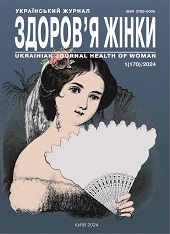Maternal and fetal arrhythmia as a sign of hemodynamic deterioration: a case report
DOI:
https://doi.org/10.15574/HW.2024.170.87Keywords:
maternal arrhythmia, fetal arrhythmia, Ballantyne’s syndrome, transplacental treatmentAbstract
The co-existing maternal (MA) and fetal arrythmia (FA) are associated with maternal goiter disease, chorioamnionitis, or Ballantyne’s syndrome.
The aim of the study - to determine the involvement of maternal arrhythmia and fetal arrhythmia in the pathogenic scenario of hemodynamic deterioration in Ballantyne’s syndrome.
Clinical case. It is presented the case of sustained several weeks of MA and FA. A pregnant woman aged 36 years was admitted to the division of maternal and fetal medicine at 34 weeks of gestation. She was gravida 4 and para 3. She had complaints of rapid heartbeat, left-side chest discomfort, and lower extremities edema. The diagnosis of maternal sinus tachycardia was supported via electrocardiography. The indices of fetal, umbilical, and uteroplacental hemodynamics detected via Doppler ultrasound were appropriate. However, fetal heart rate was 209 beats/min. The transplacental attack of oral sotalol 80 mg thrice daily was prescribed. But maternal and fetal tachycardia persisted to stay. The tricuspid regurgitation was detected via Doppler ultrasound next day. The fetus was hydropic. The male baby of 2400 g, 46 cm length, 31 cm head circumference, and Apgar score 3→5 was delivered via caesarean. The newborn was discharged in 21 days. He was admitted again in one month for rehabilitation. Maternal heart rate reduced to 72 beats/min and edema regressed in three days after birth.
Conclusions. MA and FA before fetal hydrops are supposed to be the early signs of mirror syndrome. This speculation needs further investigation.
The research was carried out in accordance with the principles of the Helsinki Declaration. The informed consent of the patient was obtained for conducting the studies.
No conflict of interests was declared by the authors.
References
Lakhno I, Kniazkova I, Lakhno O, Uzel K. (2022). Dysautonomia involvement in maternal cardiac arrhythmia. Arch Balk Med Union. 57(1): 17-22. https://doi.org/10.31688/ABMU.2022.57.1.02
Ekici H, Ökmen F, İmamoğlu M, İmamoğlu AG, Ergenoğlu AM. (2022, Dec 13). Fetal arrhythmias: Ten years' experience and review of the literature. Turk J Obstet Gynecol. 19(4): 302-307. https://doi.org/10.4274/tjod.galenos.2022.61818; PMid:36511630 PMCid:PMC9748861
Hogen Esch E, Dahl C, Samworth A, Venkatachalam S, Rajan P, Lange EMS. (2022, Nov 15). Atrial fibrillation with rapid ventricular response as a maternal presentation of mirror syndrome: a case report. Case Rep Womens Health. 36: e00469. https://doi.org/10.1016/j.crwh.2022.e00469; PMid:36425248 PMCid:PMC9679469
Lakhno I, Behar JA, Oster J, Shulgin V, Ostras O, Andreotti F. (2017, Aug 3). The use of non-invasive fetal electrocardiography in diagnosing second-degree fetal atrioventricular block. Matern Health Neonatol Perinatol. 3: 14. https://doi.org/10.1186/s40748-017-0053-1; PMid:28794892 PMCid:PMC5541729
Yuan SM. (2019, Mar-Apr). Fetal arrhythmias: Surveillance and management. Hellenic J Cardiol. 60(2): 72-81. https://doi.org/10.1016/j.hjc.2018.12.003; PMid:30576831
Mathias CR, Rizvi C. (2019, May 14). The diagnostic conundrum of maternal mirror syndrome progressing to pre-eclampsia - A case report. Case Rep Womens Health. 23: e00122. https://doi.org/10.1016/j.crwh.2019.e00122; PMid:31193796 PMCid:PMC6542765
Mohamad Zon E, Nik Lah NAZ, Hoo PS. (2021, Feb 15). Late-Onset Mirror Syndrome. Malays Fam Physician. 16(1):129-132. https://doi.org/10.51866/cr1099; PMid:33948153 PMCid:PMC8088733
Sharp A, Patient C, Pickett J, Belham M. (2021, Dec). Pregnancy-related inappropriate sinus tachycardia: A cohort analysis of maternal and fetal outcomes. Obstet Med. 14(4): 230-234. https://doi.org/10.1177/1753495X21990196; PMid:34880936 PMCid:PMC8646219
Mogharbel H, Hunt J, D'Souza R, Hobson SR. (2022, Sep). Clinical presentation and maternal-fetal outcomes of Mirror Syndrome: A case series of 10 affected pregnancies. Obstet Med. 15(3): 190-194. https://doi.org/10.1177/1753495X211058043; PMid:36262819 PMCid:PMC9574449
Strasburger JF. (2023, Oct). Maturity makes sense: managing supraventricular tachyarrhythmia in the late preterm and term fetus. Ultrasound Obstet Gynecol. 62(4): 457-458. https://doi.org/10.1002/uog.27449; PMid:37674312
Downloads
Published
Issue
Section
License
Copyright (c) 2024 Ukrainian Journal Health of Woman

This work is licensed under a Creative Commons Attribution-NonCommercial 4.0 International License.
The policy of the Journal UKRAINIAN JOURNAL «HEALTH OF WOMAN» is compatible with the vast majority of funders' of open access and self-archiving policies. The journal provides immediate open access route being convinced that everyone – not only scientists - can benefit from research results, and publishes articles exclusively under open access distribution, with a Creative Commons Attribution-Noncommercial 4.0 international license (СС BY-NC).
Authors transfer the copyright to the Journal UKRAINIAN JOURNAL «HEALTH OF WOMAN» when the manuscript is accepted for publication. Authors declare that this manuscript has not been published nor is under simultaneous consideration for publication elsewhere. After publication, the articles become freely available on-line to the public.
Readers have the right to use, distribute, and reproduce articles in any medium, provided the articles and the journal are properly cited.
The use of published materials for commercial purposes is strongly prohibited.

